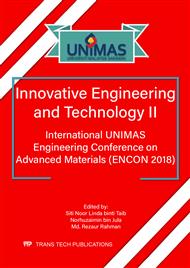p.49
p.57
p.69
p.77
p.85
p.93
p.103
p.113
p.121
Performance of Low Cost 3D Printed Minimum Quantity Lubrication Applicator Using Palm Oil in Milling Steel
Abstract:
One of the most significant factors in machining process or metal cutting is the cutting tool performance. The rapid wear rate of cutting tools and cutting forces expend due to high cutting temperature is a critical problem to be solved in high-speed machining process, milling. Near-dry machining such as minimum quantity lubrication (MQL) is regarded as one of the solutions to solve this problem. However, the function of MQL in milling process is still uncertain so far which prevents MQL from widely being utilized in this specific machining process. In this paper, the mechanism of cutting tool performance such as tool wear and cutting forces in MQL assisted milling is investigated more comprehensively and the results are compared in three different cutting conditions which is dry cutting, wet cutting (flooding) and MQL. The MQL applicator is constructed from a household grade low-cost 3D printing technique. The chips surface of chips formation in each cutting condition is also observed using Scanning Electron Microscopy (SEM) machine. It is found out that wet cutting (flooding) is the best cutting performance compare to MQL and dry cutting. However, it can also be said that wet cutting and MQL produced almost the same value of tool wear and cutting forces as there is negligible differences in average tool wear and cutting forces between them based on the experiment conducted.
Info:
Periodical:
Pages:
85-92
Citation:
Online since:
June 2020
Keywords:
Price:
Сopyright:
© 2020 Trans Tech Publications Ltd. All Rights Reserved
Share:
Citation:


